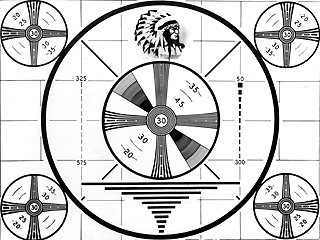.gif)

.gif) |
|
|---|
Pre-
|
Pre-1950 |
|
Visitors to the Little Bighorn Battlefield National Monument are still confronted with the following tribute in stone, which erases the crimes of colonial aggression & land-theft by the final epithet, "hostile Indians." (Hey, wouldn't you have been hostile, too?) Since the monument and text are mentioned in a book from the 1880's, it must have been one of the earliest official markers on the site. . . . I'm reminded of seeing the Croc Hunter, Steve Irwin, on one of his TV episodes, jabbing at a poisonous snake with a stick: "When you poke them with a stick, they tend to get irritable and aggressive" (that is—hostile). Even my seven-year-old daughter had the sense to say, "Well, stop poking it, then!"  |
||
|
My Mniconjou Lakota grandmother's 1943 photograph is perplexing & problematic, to say the least. A Native woman with a male chief's headdress is certainly plain wrong, a bogus Indian representation coerced by the white powers-that-be who were in charge of a Pierre, SoDak public parade.* And it was a parade largely spurred, no doubt, by World War II American patriotism: "Hey, let's get some local Injuns all dressed up in their full regalia, too!"—as further moral support for the cause, I would guess, and with perhaps the implicit agenda that these "defeated people" might serve as fine reminders of the U.S. military's might. * The irony continues: my mom has recently informed me that it was a Lewis & Clark parade—and that Grandma was—gasp—"Sacajawea"! Geez, I'm sure that that was her tribal garb! . . . |
.jpg) |
|
|---|---|---|
. . . But then identities, especially representations thereof, are always in flux, and fraught with gradations—or "shades": |
 |
|
(I found the book pictured on the right in a used-book store a few years back.) In 1903, the naturalist writer Ernest Thompson Seton wrote a book called Two Little Savages, about two Eastern white boys who decide, "'Let's be Injuns and do everything like Injuns.'" The more ambitious of the two "tried to do everything as an Indian would do it, striking Indian poses, walking carefully with his toes turned in . . . and grunting 'Ugh' . . . when anything surprised him. Disparaging remarks about White-men, delivered in supposed Indian dialect, were an important part of his pastime"—as in "'White-men heap no-good.'" Later, with more boys recruited into this Indian regimen and regiment, one says, "'we want to play Injun properly'"—to which another asks, "'Ye mean by scalping the whites an' horse-stealing?'"! . . . But the point of the book, finally, is to teach white towns-kids "woodscraft," as Seton called it, with the assumption that Native knowledge of the woods, the animals, the land in general, was vastly superior to that of whites. Seton was instrumental, by the way, in founding the Boy Scouts, and thus much of that group's iconography and rituals remains a bastardization of Native cultural practices. However, the modern reader cannot read such a pedagogical manual without laughing out loud, without being reminded of the "lost boys" of Disney's Peter Pan, out "playing at Indian" themselves, goofy-looking coonskin caps firmly on head.
|
 |
|
A graduate student alerted me to the graphic on the left, a 1945 postcard of "SACAJAWEA, GIRL INDIAN GUIDE," as the print on the top of the card tells us. She looks more like some Norse goddess/soprano from a Wagner opera, and her "feathers" remind me as much of Thor's helmet as some Native headdress. What is most striking, of course, is how white she is, a gross act of literal, physical assimilation, an appropriation of the Native into the discourse of the "Same." And there is no doubt some (subtle or not) colonialist rationale going on here: "Hey, we're the same color as you are. So it's cool with us if you take our land!" (Also, "Girl" instead of "Woman" is yet another verbal act of belittlement, of puerilization.) |
 |
|
For much of the 20th century (1906?-2001), in various manifestations, these large-ruled (no: huge-ruled!) notebooks were the repository for the misshapen scribblings of many a grade-schooler. I'm not sure how the sight of a Plains Indian chief was supposed to inspire good penmanship: it's as if the image of the conquered-yet-"noble savage" ran (or rode) rampant in the 20th-century logos of business and education, as if to defy "reservation" containment. (Or maybe the subtext of the tablet's cover was—"Don't be a savage: learn how to write!") [I'm still trying to find the cover version I owned as a boy in the 1960's. Those shown here are even older.] |
  |
|
The RCA "Indian Head" (1939-) was perhaps the most common icon for 1st- (and 2nd-) generation television viewers, when the network was off-air: I guess even the new technology needed that "ol' nostalgia." I remember, as a kid, staring at this mind-wrecker early Saturday mornings in the 1960's, waiting for the cartoons to come on—and thinking, "What's that Indi'n doin' up there?" But hey, I do like the "four-directions"/mandala schema. . . . |
 |
|
"Calumet Baking Powder" goes back as far as 1889, was eventually acquired by General Foods (1929), and henceforth has been a longtime staple in U.S. kitchens. Combine this ubiquitous culinary icon with the ebullient smile of Aunt Jemima, and the white bourgeois housewife has had a lot of "good medicine," apparently, from minority cultures with which to please the palates of her All-American-happy family. . . . "Calumet," by the way, is purportedly French-Canadian for the Native American "peace pipe." Though the choice of product name had little connection with this etymology—that is, Calumet Farm was simply the name of the originator's racing stable—one can't help but wonder what all these housewives have been trying to find peace from. (And/or: is the headdressed "fierce warrior" and the "peaceful" product name a deconstruction in itself, of contradictory signifiers?) |
 |
|